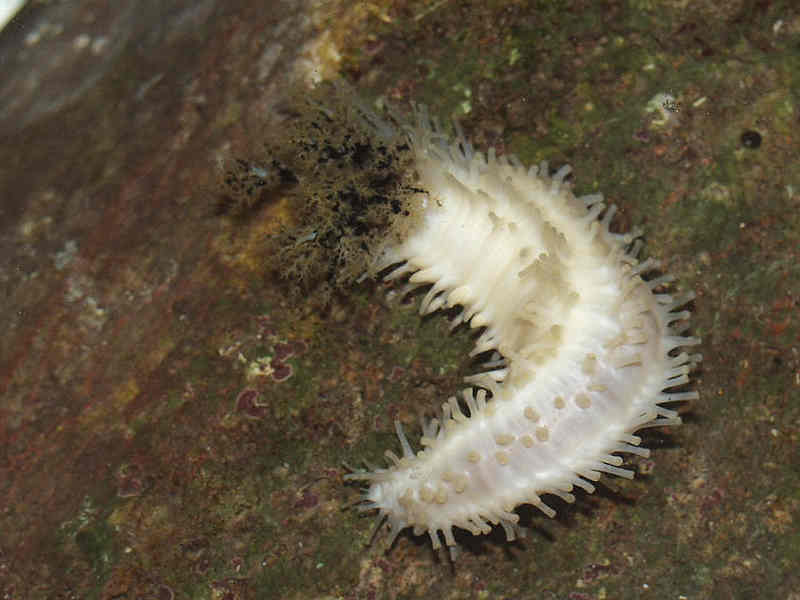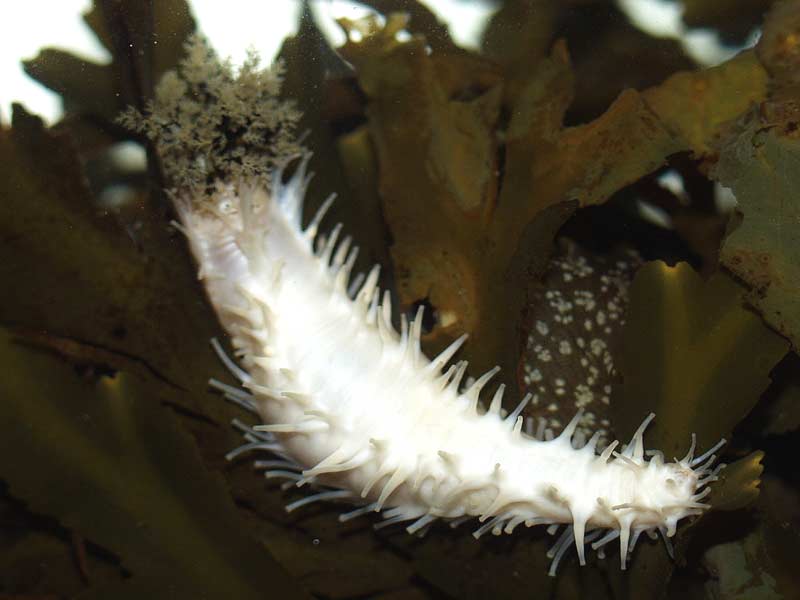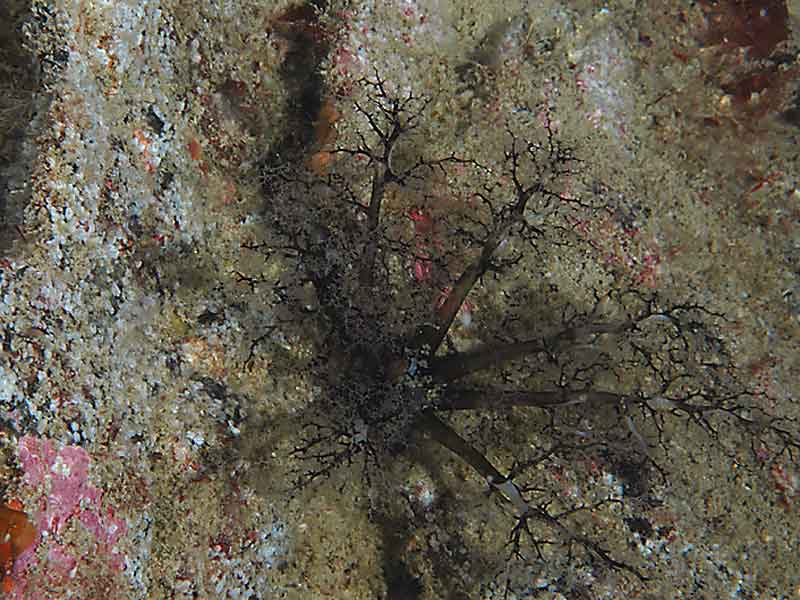Sea gherkin (Pawsonia saxicola)
Distribution data supplied by the Ocean Biodiversity Information System (OBIS). To interrogate UK data visit the NBN Atlas.Map Help
| Researched by | Olwen Ager | Refereed by | Admin |
| Authority | (Brady & Robertson, 1871) | ||
| Other common names | - | Synonyms | Cucumaria saxicola (Brady & Robertson, 1871) |
Summary
Description
Recorded distribution in Britain and Ireland
Pawsonia saxicola is found on the south and west coasts of the British and Ireland.Global distribution
Pawsonia saxicola is found on the Atlantic coast of France southwards to the Azores.Habitat
Pawsonia saxicola is found in rock crevices and under boulders from the lower shore to about 50 m.Depth range
-Identifying features
- Cylindrical white body, up to 15 cm in length.
- 5 rows of long tube feet.
- Star shaped spicules.
- 10 mottled black tentacles, up to 10 cm in length)
- Found in rock crevices and beneath boulders.
Additional information
Pawsonia saxicola may be confused with Aslia lefevrei as both species have similar tentacles. However, Pawsonia saxicola has a distinctive white body, while the body of Aslia lefevrei is brown in colour.Listed by
- none -
Bibliography
Fish, J.D. & Fish, S., 1996. A student's guide to the seashore. Cambridge: Cambridge University Press.
Hayward, P.J. & Ryland, J.S. (ed.) 1995b. Handbook of the marine fauna of North-West Europe. Oxford: Oxford University Press.
Howson, C.M. & Picton, B.E., 1997. The species directory of the marine fauna and flora of the British Isles and surrounding seas. Belfast: Ulster Museum. [Ulster Museum publication, no. 276.]
Hyman, L.V., 1955. The Invertebrates: Vol. IV. Echinodermata. The coelomate Bilateria. New York: McGraw Hill.
JNCC (Joint Nature Conservation Committee), 1999. Marine Environment Resource Mapping And Information Database (MERMAID): Marine Nature Conservation Review Survey Database. [on-line] http://www.jncc.gov.uk/mermaid
Mortensen, T.H., 1927. Handbook of the echinoderms of the British Isles. London: Humphrey Milford, Oxford University Press.
Picton, B.E. & Costello, M.J., 1998. BioMar biotope viewer: a guide to marine habitats, fauna and flora of Britain and Ireland. [CD-ROM] Environmental Sciences Unit, Trinity College, Dublin.
Picton, B.E., 1993. A field guide to the shallow-water echinoderms of the British Isles. London: Immel Publishing Ltd.
Datasets
Centre for Environmental Data and Recording, 2018. IBIS Project Data. Occurrence dataset: https://www.nmni.com/CEDaR/CEDaR-Centre-for-Environmental-Data-and-Recording.aspx accessed via NBNAtlas.org on 2018-09-25.
Centre for Environmental Data and Recording, 2018. Ulster Museum Marine Surveys of Northern Ireland Coastal Waters. Occurrence dataset https://www.nmni.com/CEDaR/CEDaR-Centre-for-Environmental-Data-and-Recording.aspx accessed via NBNAtlas.org on 2018-09-25.
Fenwick, 2018. Aphotomarine. Occurrence dataset http://www.aphotomarine.com/index.html Accessed via NBNAtlas.org on 2018-10-01
NBN (National Biodiversity Network) Atlas. Available from: https://www.nbnatlas.org.
OBIS (Ocean Biodiversity Information System), 2025. Global map of species distribution using gridded data. Available from: Ocean Biogeographic Information System. www.iobis.org. Accessed: 2025-07-01
Citation
This review can be cited as:
Last Updated: 07/06/2007





